The Deterioration of C-S-H Gel in a Severe Sulfate Environment
Abstract
:1. Introduction
2. Experimental Work
2.1. Material and Sample Preparation
2.2. Characterization
3. Results and Discussion
3.1. XRD Analysis
3.2. SEM-EDS Analysis
3.3. 29Si and 27Al MAS-NMR Analysis
4. Conclusions
Author Contributions
Funding
Data Availability Statement
Conflicts of Interest
References
- Hossain, M.M.; Karim, M.R.; Hasan, M.; Hossain, M.K.; Zain, M.F.M. Durability of mortar and concrete made up of pozzolans as a partial replacement of cement: A review. Constr. Build. Mater. 2016, 116, 128–140. [Google Scholar] [CrossRef]
- Tang, S.W.; Yao, Y.; Andrade, C.; Li, Z.J. Recent durability studies on concrete structure. Cem. Concr. Res. 2015, 78, 143–154. [Google Scholar] [CrossRef]
- Niu, D.T.; De Wang, Y.; Ma, R.; Wang, J.B.; Xu, S.H. Experiment study on the failure mechanism of dry-mix shotcrete under the combined actions of sulfate attack and drying-wetting cycles. Constr. Build. Mater. 2015, 81, 74–80. [Google Scholar] [CrossRef]
- Whittaker, M.; Black, L. Current knowledge of external sulfate attack. Adv. Cem. Res. 2015, 27, 532–545. [Google Scholar] [CrossRef]
- Santhanam, M.; Cohen, M.D.; Olek, J. Sulfate attack research—Whither now? Cem. Concr. Res. 2001, 31, 845–851. [Google Scholar] [CrossRef]
- Schmidt, T.; Lothenbach, B.; Romer, M.; Neuenschwander, J.; Scrivener, K. Physical and microstructural aspects of sulfate attack on ordinary and limestone blended Portland cements. Cem. Concr. Res. 2009, 39, 1111–1121. [Google Scholar] [CrossRef]
- Hansen, W.C. Attack of Portland cement concrete by alkali soils and waters—A critical review. Highw. Res. Rec. 1966, 113, 1–32. [Google Scholar]
- Ding, Q.; Yang, J.; Hou, D.; Zhang, G. Insight on the mechanism of sulfate attacking on the cement paste with granulated blast furnace slag: An experimental and molecular dynamics study. Constr. Build. Mater. 2018, 169, 601–611. [Google Scholar] [CrossRef]
- Hou, D.; Li, T.; Wang, P. Molecular Dynamics Study on the Structure and Dynamics of NaCl Solution Transport in the Nanometer Channel of CASH Gel. ACS Sustain. Chem. Eng. 2018, 6, 9498–9509. [Google Scholar] [CrossRef]
- Müllauer, W.; Beddoe, R.E.; Heinz, D. Sulfate attack expansion mechanisms. Cem. Concr. Res. 2013, 52, 208–215. [Google Scholar] [CrossRef]
- Scherer, G.W. Crystallization in Pores. Cem. Concr. Res. 1999, 29, 1347–1358. [Google Scholar] [CrossRef]
- Scherer, G.W. Stress from crystallization of salt. Cem. Concr. Res. 2004, 34, 1613–1624. [Google Scholar] [CrossRef]
- Yang, Z.; Zhang, W.; Zhu, H.; Chen, Y.; Xu, L.; Wang, P.; Lai, Y. Thaumasite form of sulfate attack in ettringite rich-ternary systems: Effects of limestone filler, etching solutions and exposure temperature. Dev. Built Environ. 2023, 15, 100208. [Google Scholar] [CrossRef]
- Crammond, N. The occurrence of thaumasite in modern construction—A review. Cem. Concr. Compos. 2002, 24, 393–402. [Google Scholar] [CrossRef]
- Shafaghat, J.; Allahverdi, A. Enhancing Concrete Properties by Using Silica Fume as Reactive Powder and Portland Cement-Clinker as Reactive Aggregate. J. Mater. Civ. Eng. 2019, 31, 04019278. [Google Scholar] [CrossRef]
- Dolado, J.S.; Campillo, I.; Erkizia, E.; Ibáñez, J.A.; Porro, A.; Guerrero, A.; Goñi, S. Effect of nanosilica additions on belite cement pastes held in sulfate solutions. J. Am. Ceram. Soc. 2007, 90, 3973–3976. [Google Scholar] [CrossRef]
- Jennings, H.M. A model for the microstructure of calcium silicate hydrate in cement paste. Cem. Concr. Res. 2000, 30, 101–116. [Google Scholar] [CrossRef]
- Pellenq, R.J.M.; Lequeux, N.; van Damme, H. Engineering the bonding scheme in C-S-H: The iono-covalent framework. Cem. Concr. Res. 2008, 38, 159–174. [Google Scholar] [CrossRef]
- Lothenbach, B.; Nonat, A. Calcium silicate hydrates: Solid and liquid phase composition. Cem. Concr. Res. 2015, 78, 57–70. [Google Scholar] [CrossRef]
- Tennis, P.D.; Jennings, H.M. Model for two types of calcium silicate hydrate in the microstructure of Portland cement pastes. Cem. Concr. Res. 2000, 30, 855–863. [Google Scholar] [CrossRef]
- Jennings, H.M. Refinements to colloid model of C-S-H in cement: CM-II. Cem. Concr. Res. 2008, 38, 275–289. [Google Scholar] [CrossRef]
- Mondai, P.; Shah, S.R.; Marks, L.D. Nanoscale characterization of cementitious materials. ACI Mater. J. 2008, 105, 174–179. [Google Scholar] [CrossRef] [PubMed]
- Pomberger, R.; Sarc, R. Use of Solid Recovered Fuels in the Cement Industry. Waste Manag. 2014, 4, 471–488. [Google Scholar]
- Zschiesche, W.; Menzel, K. System for the use of alternative fuels in cement production, part one: Alternative fuels and raw materials. World Cem. 2014, 17, 225–276. [Google Scholar]
- Ferrari, L.; Bernard, L.; Deschner, F.; Kaufmann, J.; Winnefeld, F.; Plank, J. Characterization of polycarboxylate-ether based superplasticizer on cement clinker surfaces. J. Am. Ceram. Soc. 2012, 95, 2189–2195. [Google Scholar] [CrossRef]
- Plank, J.; Zhimin, D.; Keller, H.; Hössle, F.V.; Seidl, W. Fundamental mechanisms for polycarboxylate intercalation into C3A hydrate phases and the role of sulfate present in cement. Cem. Concr. Res. 2010, 40, 45–57. [Google Scholar] [CrossRef]
- Ferrari, L.; Kaufmann, J.; Winnefeld, F.; Plank, J. Impact of particle size on interaction forces between ettringite and dispersing comb-polymers in various electrolyte solutions. J. Colloid Interface Sci. 2014, 419, 17–24. [Google Scholar] [CrossRef] [PubMed]
- Irbe, L.; Beddoe, R.E.; Heinz, D. The role of aluminium in C-A-S-H during sulfate attack on concrete. Cem. Concr. Res. 2019, 116, 71–80. [Google Scholar] [CrossRef]
- Steindl, F.R.; Baldermann, A.; Galan, I.; Sakoparnig, M.; Briendl, L.; Dietzel, M.; Mittermayr, F. Chemical resistance of eco-concrete–Experimental approach on Ca-leaching and sulphate attack. Constr. Build. Mater. 2019, 223, 55–68. [Google Scholar] [CrossRef]
- GB2007; Common Portland Cement. China Standards Press: Beijing, China, 2008.
- Richardson, I.G. Nature of the hydration products in hardened cement pastes. Cem. Concr. Compos. 2000, 22, 97–113. [Google Scholar] [CrossRef]
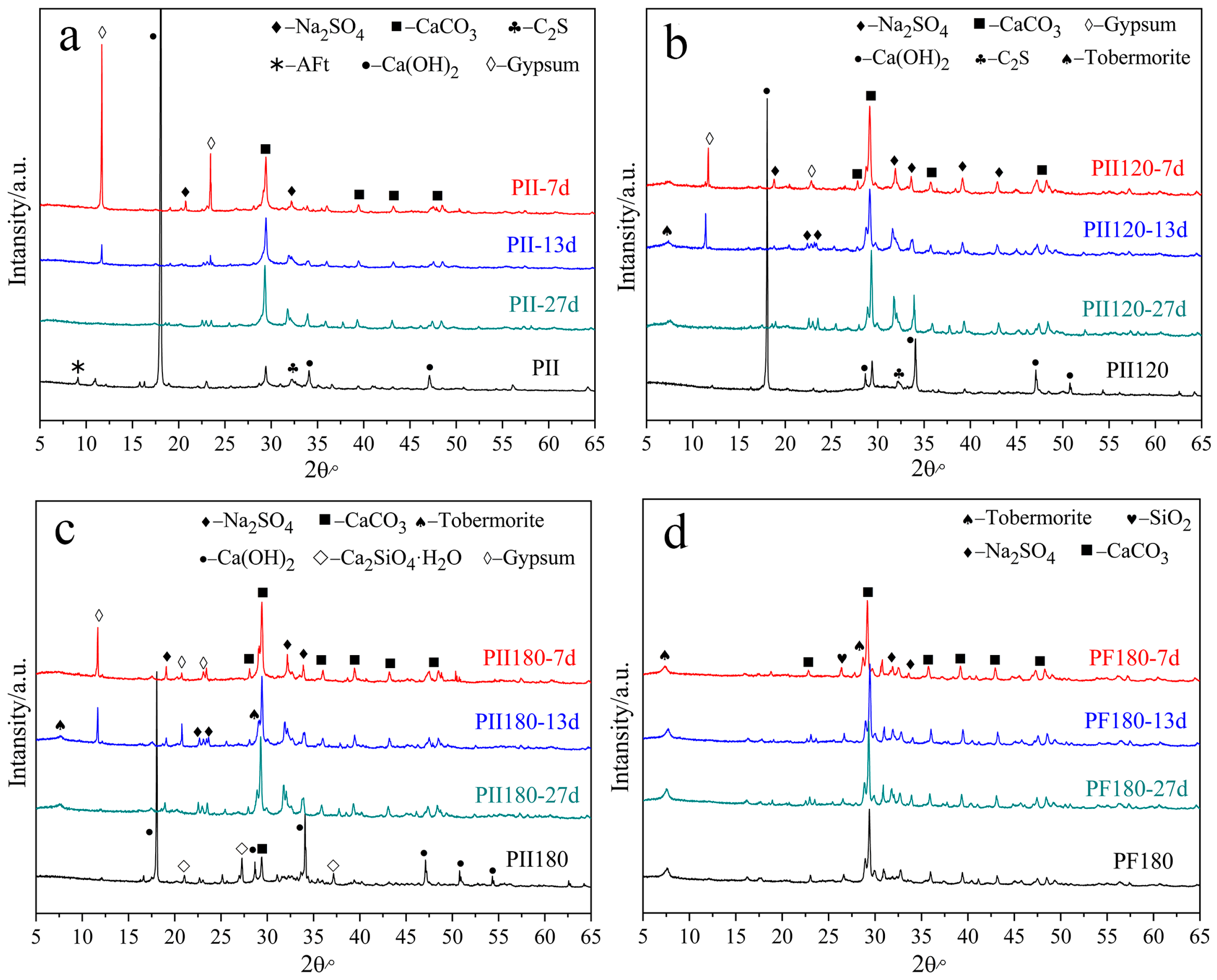
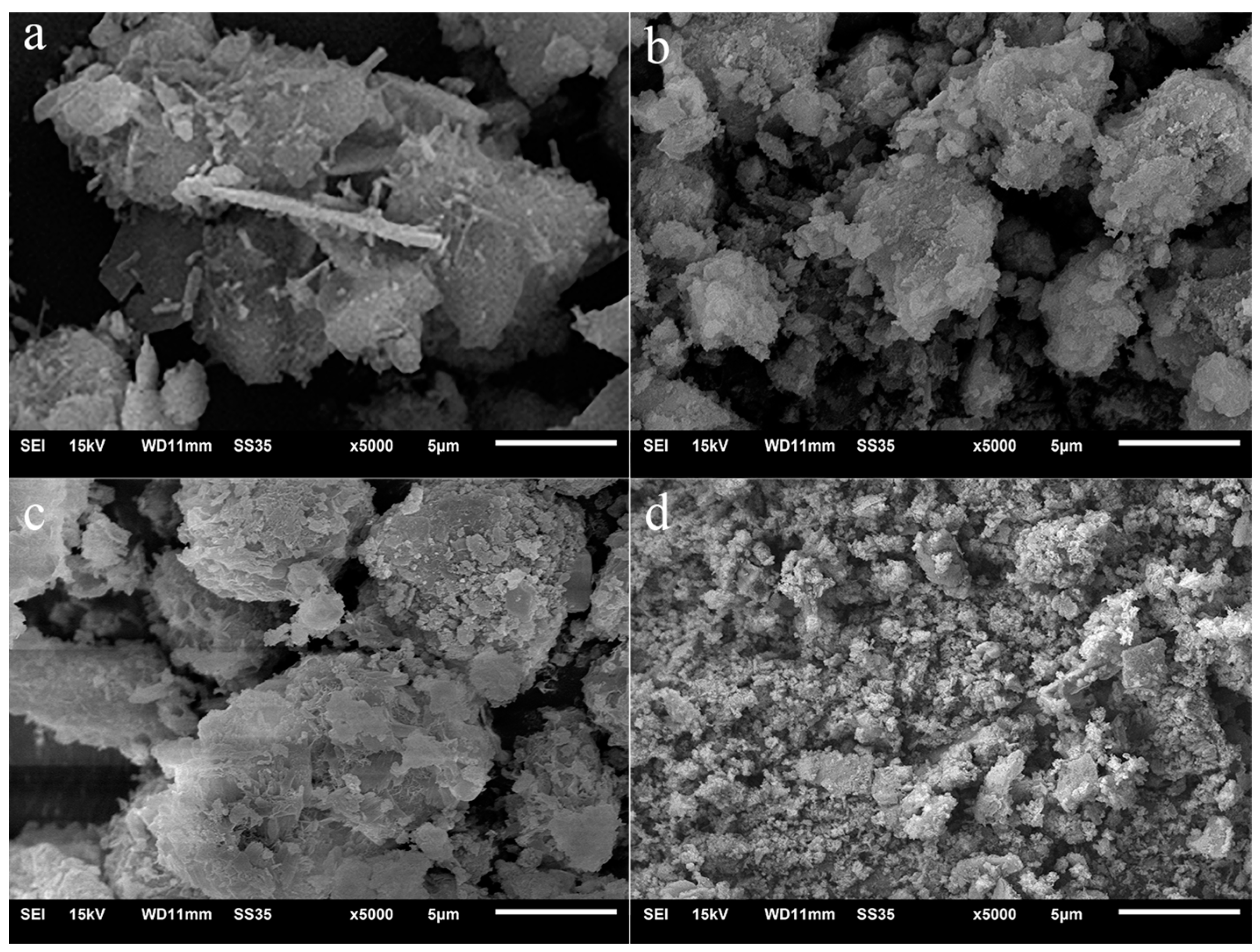

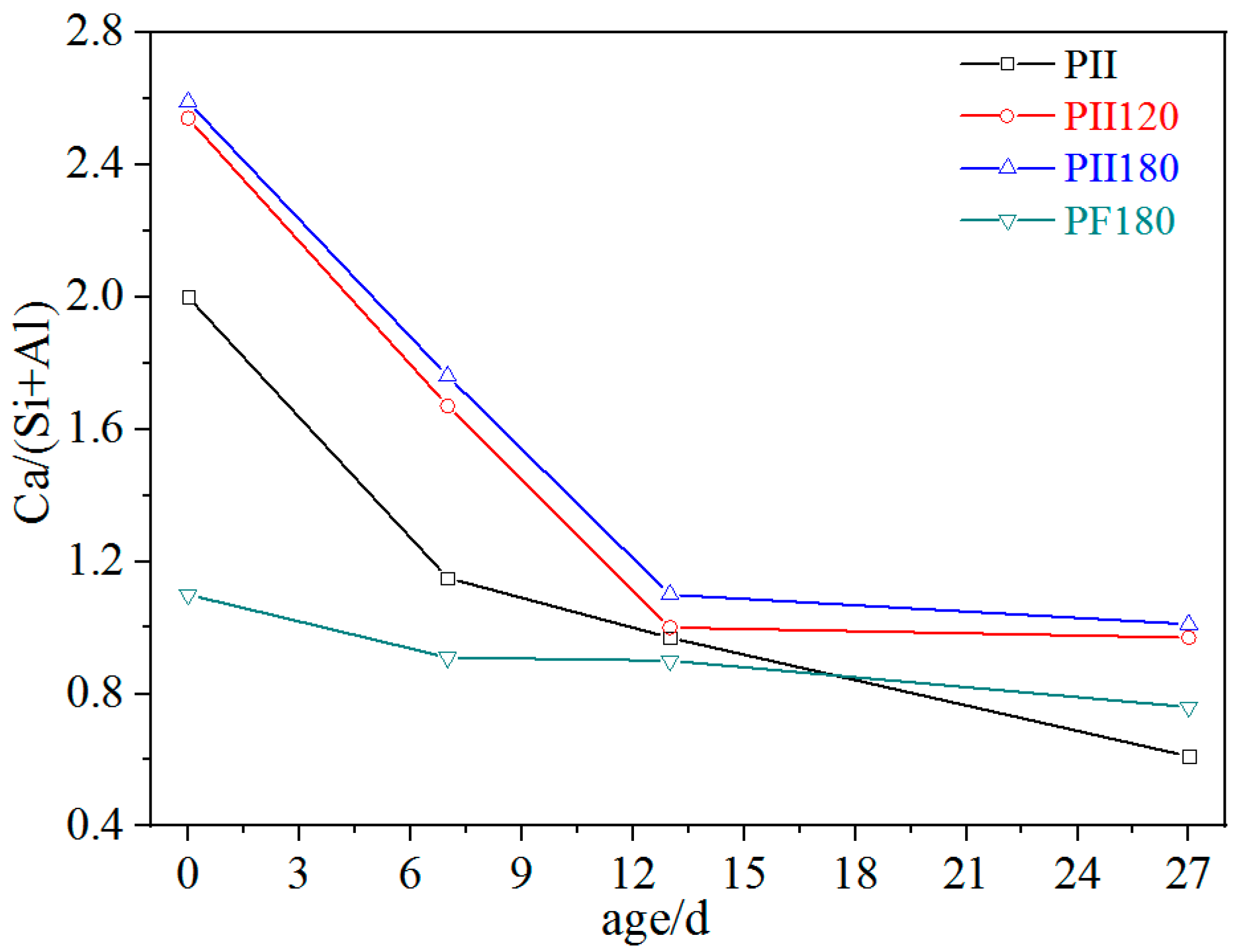
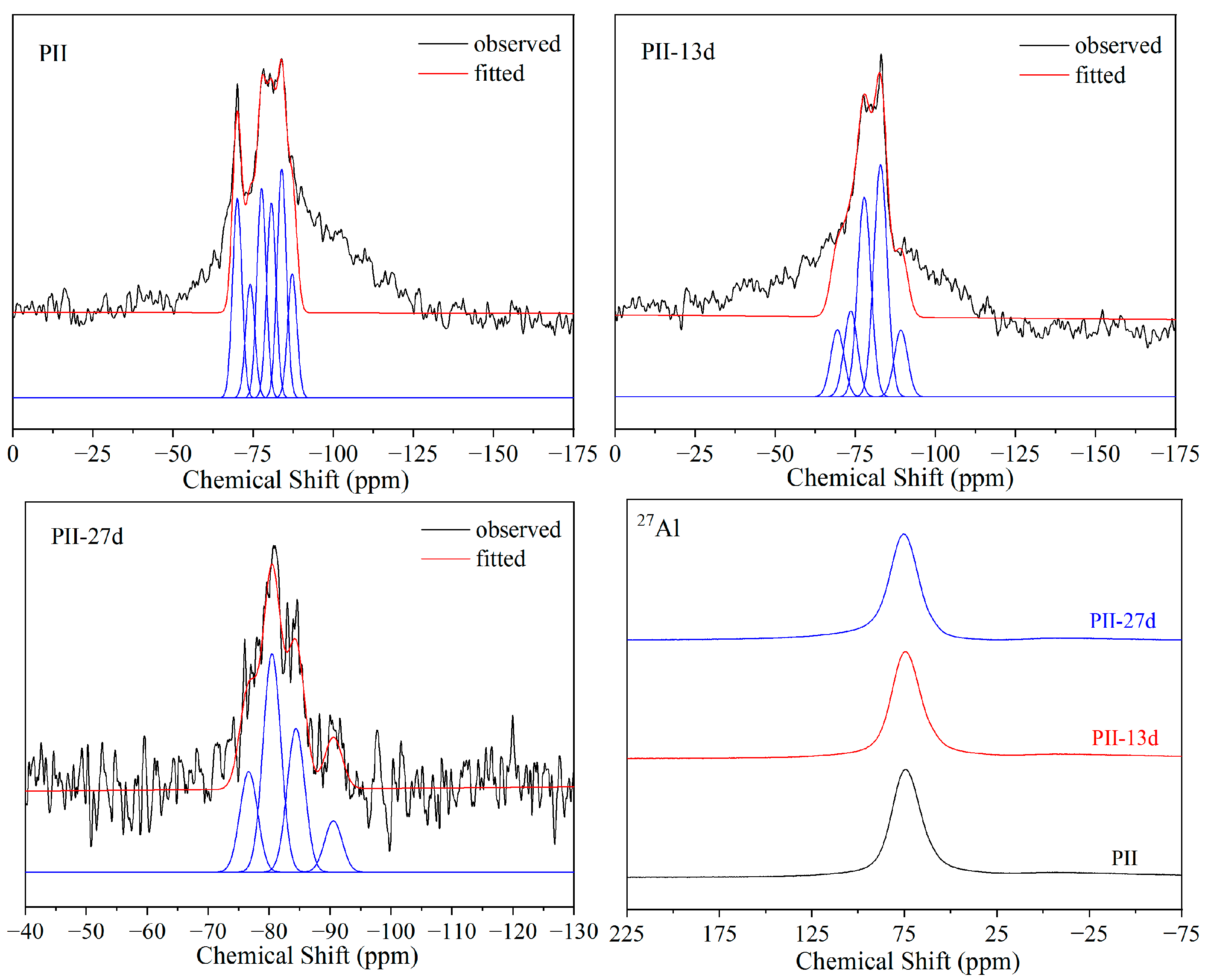

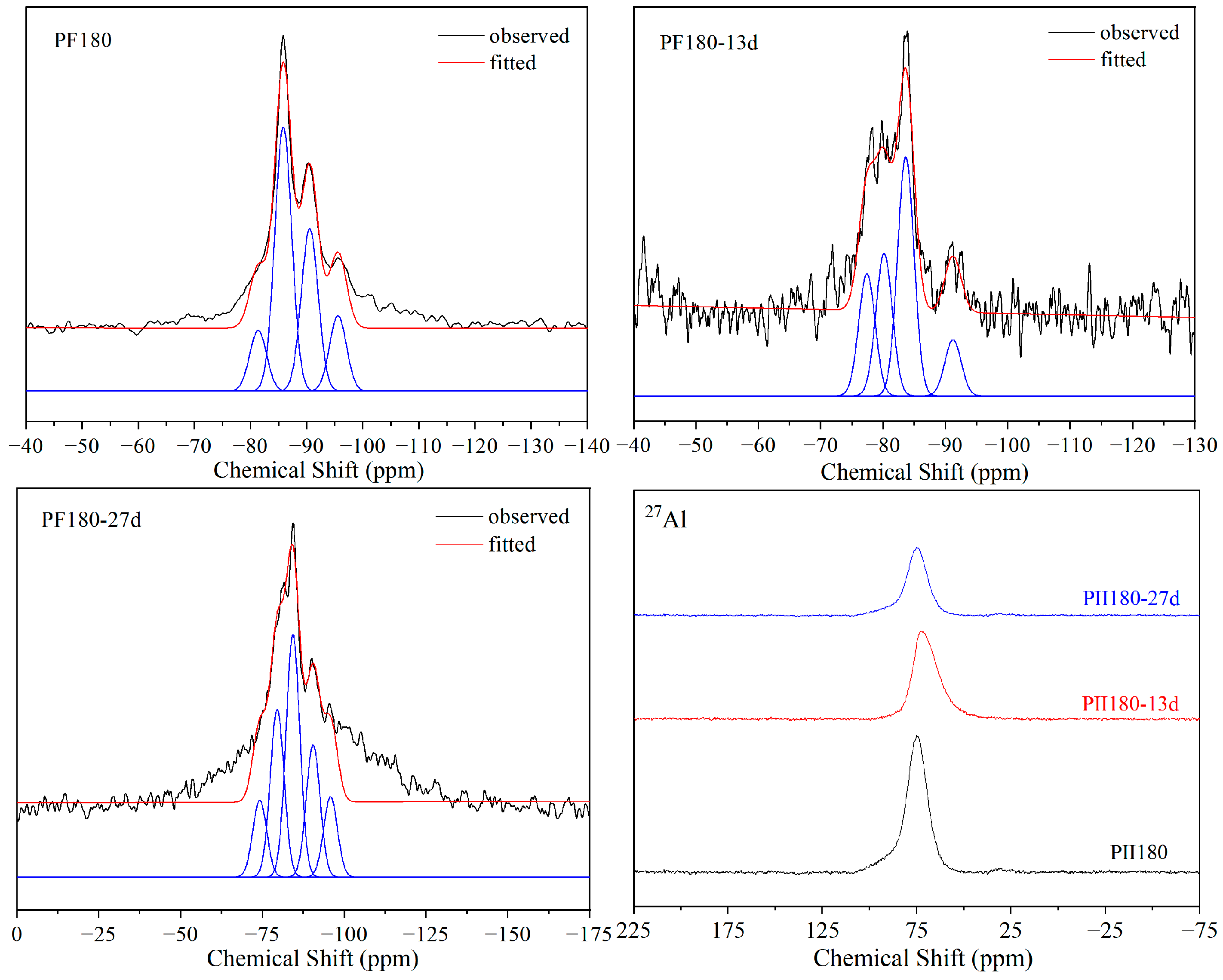
| Composition | SiO2 | Al2O3 | CaO | Fe2O3 | MgO | K2O | Na2O | SO3 | LOI |
|---|---|---|---|---|---|---|---|---|---|
| Cement | 19.14 | 4.39 | 64.73 | 2.97 | 0.89 | 0.5 | 0.18 | 2.16 | 2.4 |
| Fly ash | 57.89 | 28.38 | 1.39 | 3.81 | 0.91 | 1.76 | 0.58 | 0.06 | 2.75 |
| Si Sites | Q1 | Q2(1Al) | Q2 | Q3 | CL |
|---|---|---|---|---|---|
| PII | 21.88% | 20.35% | 23.91% | 12.98% | 6.98 |
| PII-13d | 17.93% | 30.66% | 33.48% | 8.93% | 10.86 |
| PII-27d | 19.57% | 42.47% | 27.97% | 9.99% | 11.37 |
| PII180 | 22.26% | 28.95% | 40.60% | 8.18% | 9.55 |
| PII180-13d | 14.76% | 46.47% | 23.16% | 15.61% | 14.58 |
| PII180-27d | 14.12% | 41.93% | 27.83% | 16.12% | 14.85 |
| PF180 | 10.78% | 46.94% | 28.87% | 13.40% | 20.42 |
| PF180-13d | 21.83% | 25.46% | 42.68% | 10.04% | 9.41 |
| PF180-27d | 10.99% | 23.96% | 34.64% | 18.91% | 14.84 |
Disclaimer/Publisher’s Note: The statements, opinions and data contained in all publications are solely those of the individual author(s) and contributor(s) and not of MDPI and/or the editor(s). MDPI and/or the editor(s) disclaim responsibility for any injury to people or property resulting from any ideas, methods, instructions or products referred to in the content. |
© 2024 by the authors. Licensee MDPI, Basel, Switzerland. This article is an open access article distributed under the terms and conditions of the Creative Commons Attribution (CC BY) license (https://creativecommons.org/licenses/by/4.0/).
Share and Cite
Liao, W.; Lu, C.; Xu, Z. The Deterioration of C-S-H Gel in a Severe Sulfate Environment. Symmetry 2024, 16, 703. https://doi.org/10.3390/sym16060703
Liao W, Lu C, Xu Z. The Deterioration of C-S-H Gel in a Severe Sulfate Environment. Symmetry. 2024; 16(6):703. https://doi.org/10.3390/sym16060703
Chicago/Turabian StyleLiao, Wei, Chunhua Lu, and Zhongzi Xu. 2024. "The Deterioration of C-S-H Gel in a Severe Sulfate Environment" Symmetry 16, no. 6: 703. https://doi.org/10.3390/sym16060703





